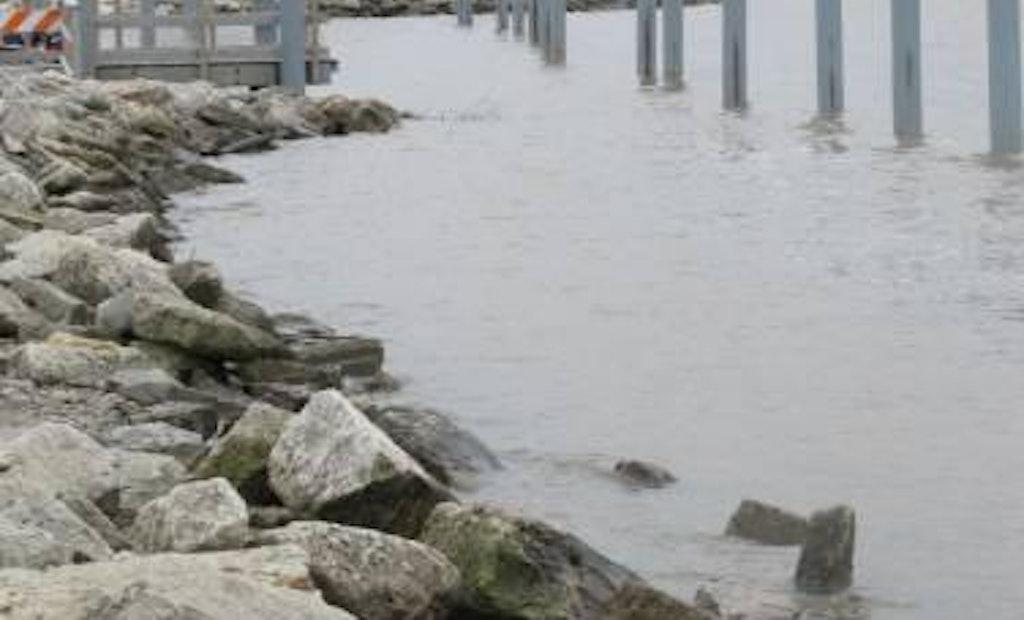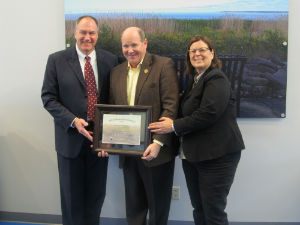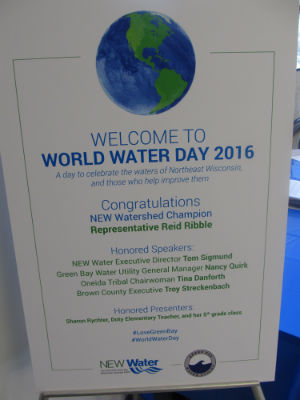
Interested in Education/Training?
Get Education/Training articles, news and videos right in your inbox! Sign up now.
Education/Training + Get Alerts“Never forget that you live at the mouth of the largest freshwater estuary in the world. And never forget the great responsibility you bear for that.” – Dr. Harold “Jack” Day, former NEW Water Commission President and University of Wisconsin-Green Bay professor emeritus
Those words grace a wall of the Jack Day Environmental Education Center, a division of NEW Water in Green Bay, Wisconsin. The quote is a daily reminder of the importance of water, and it explains why the utility created the NEW Watershed Champion award, which honors individuals who uphold watershed conservation and stewardship.
This year’s winner is U.S. Rep. Reid Ribble (Republican, 8th District) for his “Save the Bay” efforts.
 “This year was such an obvious choice,” says Bill Hafs, NEW Water’s director of environmental programs.
“This year was such an obvious choice,” says Bill Hafs, NEW Water’s director of environmental programs.
Ribble was honored March 18 by NEW Water Executive Director Tom Sigmund, Green Bay Water Utility General Manager Nancy Quirk and local municipality executives.
A history of helping
Ribble has long led efforts to save Green Bay from summer dead zones and fish die-offs caused by heavy nutrient loads. Last year, Ribble sponsored H.R. 3120, the Great Lakes Assurance Program Verification Act of 2015.
“Green Bay and the Great Lakes are an amazing natural resource, and we have a responsibility to preserve them for our children and grandchildren,” Ribble says. “Right now, excess phosphorus and other nutrients in the water are causing algae blooms that (create) unsafe water quality during the summer.
“As a source of some of these excess nutrients, farmers have made great strides in reducing their ecological impact, but there is still more work to be done. This bill would help equip them with the tools and information they need to continue to improve our food supplies, our community, and our future.”
 Ribble, who is not seeking re-election after six years in Congress, recently announced the expansion of his Save the Bay efforts in nearby Oconto County. Oconto County paper company ST Paper has pledged $140,000 in 2016 so the county can hire a full-time conservationist for two years. The new conservationist will work with farmers and other stakeholders to reduce nutrient runoff from agricultural land and improve water quality.
Ribble, who is not seeking re-election after six years in Congress, recently announced the expansion of his Save the Bay efforts in nearby Oconto County. Oconto County paper company ST Paper has pledged $140,000 in 2016 so the county can hire a full-time conservationist for two years. The new conservationist will work with farmers and other stakeholders to reduce nutrient runoff from agricultural land and improve water quality.
At the March 18 award ceremony, Ribble said, “It’s a very challenging discussion. … It has very little to do with me other than I called the meeting.”
That meeting was a summit Ribble convened last year to discuss best practices for phosphorus reduction. However, it wasn’t just the content of the meeting that was important; it was the fact, Sigmund said, that Ribble had the power and influence to call together diverse agencies and attendees for a common goal.
Having so many regional leaders and residents attend was key, admitted Brown County Executive Troy Streckenbach. “This is a regional issue; you have to have a regional approach, (and) partnerships ultimately lead to best practices.”
Bill Hafs, NEW Water’s director of environmental programs, says Ribble brought farmers and agencies together. The summit also included water utility staff, government officials and environmental activists.
Although no one disputes wanting clean water, the phosphorus discussion is still ringed in controversy — both over its origins and its solutions. Tricia Garrison, NEW Water’s communications and education coordinator, said runoff comes from industrial, farming and municipal sources.
Farmers and the state Department of Natural Resources maintain that phosphorus, found in the manure that farmers spread on fields as fertilizer, is not a pollutant, but, rather, a nutrient. Although that might be true, the nutrient can cause algae growth, which depletes water bodies of oxygen.
According to a Green Bay Press-Gazette report, a large section of Green Bay has been identified as a dead zone, where oxygen has been depleted beyond the point of supporting fish and plants. Experts have blamed phosphorus runoff.
The bill Ribble sponsored would create an initiative for states in the Great Lakes Basin to establish innovative, proactive programs that help farms of all sizes and all commodities to prevent or minimize agricultural pollution risks.
Modeled after the Michigan Agriculture Environmental Assurance Program, the bill seeks to replicate MAEAP’s success to other states in the Great Lakes in an effort to protect shared waterways. This conservation program would be voluntary and state developed, but it also encourages collaboration with entities that have agricultural or environmental expertise, including academic and nonprofit organizations.
The bill would use existing funds from USDA’s Environmental Quality Incentives Program at $30 million over four years to provide grants to state agencies for technical and financial assistance. The bill would also help administer an agricultural nonpoint source pollution prevent program and provide financial assistance for qualified projects and activities to producers working toward verification of an assurance program.
NEW Water addresses phosphorus issue
According to Press-Gazette reports, NEW Water is responsible for an estimated 2 percent of the phosphorus in lower Green Bay. To avoid a $200 million expenditure to cut that small amount, NEW Water received permission to launch a program to reduce phosphorus runoff on mostly agricultural land on Silver Creek.
In cooperation with the Oneida Tribe of Wisconsin, NEW Water’s pilot program will create phosphorus abatement techniques on the creek, which feeds into Duck Creek and then empties into the bay. NEW Water received grant money to support the program, as well as $1.6 million from the U.S. Environmental Protection Agency. The program is expected to take five years to complete.
Ultimately, the phosphorus quandary remains, but Ribble said an important discussion was launched.
“We need to move away from pointing fingers at each other and start pointing fingers at solutions.”





